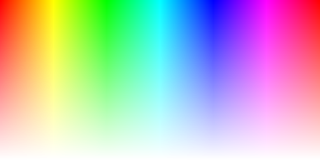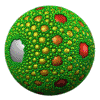Related Research Articles

In computer graphics, alpha compositing or alpha blending is the process of combining one image with a background to create the appearance of partial or full transparency. It is often useful to render picture elements (pixels) in separate passes or layers and then combine the resulting 2D images into a single, final image called the composite. Compositing is used extensively in film when combining computer-rendered image elements with live footage. Alpha blending is also used in 2D computer graphics to put rasterized foreground elements over a background.
Digital video is an electronic representation of moving visual images (video) in the form of encoded digital data. This is in contrast to analog video, which represents moving visual images in the form of analog signals. Digital video comprises a series of digital images displayed in rapid succession.

The Graphics Interchange Format is a bitmap image format that was developed by a team at the online services provider CompuServe led by American computer scientist Steve Wilhite and released on 15 June 1987. It has since come into widespread usage on the World Wide Web due to its wide support and portability between applications and operating systems.

Portable Network Graphics is a raster-graphics file format that supports lossless data compression. PNG was developed as an improved, non-patented replacement for Graphics Interchange Format (GIF) — unofficially, the initials PNG stood for the recursive acronym "PNG's not GIF".

In computer graphics and digital photography, a raster graphic represents a two-dimensional image as a rectangular matrix or grid of square pixels, viewable via a computer display, paper, or other display medium. A raster is technically characterized by the width and height of the image in pixels and by the number of bits per pixel. Raster images are stored in image files with varying dissemination, production, generation, and acquisition formats.

Image compression is a type of data compression applied to digital images, to reduce their cost for storage or transmission. Algorithms may take advantage of visual perception and the statistical properties of image data to provide superior results compared with generic data compression methods which are used for other digital data.
The BMP file format, also known as bitmap image file, device independent bitmap (DIB) file format and bitmap, is a raster graphics image file format used to store bitmap digital images, independently of the display device, especially on Microsoft Windows and OS/2 operating systems.

Interleaved Bitmap (ILBM) is an image file format conforming to the Interchange File Format (IFF) standard. The format originated on the Amiga platform, and on IBM-compatible systems, files in this format or the related PBM format are typically encountered in games from late 1980s and early 1990s that were either Amiga ports or had their graphical assets designed on Amiga machines.

Transparency is possible in a number of graphics file formats. The term "transparency" is used in various ways by different people, but at its simplest there is "full transparency" i.e. something that is completely invisible. Only part of a graphic should be fully transparent, or there would be nothing to see. More complex is "partial transparency" or "translucency" where the effect is achieved that a graphic is partially transparent in the same way as colored glass. Since ultimately a printed page or computer or television screen can only be one color at a point, partial transparency is always simulated at some level by mixing colors. There are many different ways to mix colors, so in some cases transparency is ambiguous.

Smacker video is a video file format developed by RAD Game Tools, and primarily used for full-motion video in video games. Smacker uses an adaptive 8-bit RGB palette. RAD's format for video at higher color depths is Bink Video. The Smacker format specifies a container format, a video compression format, and an audio compression format. Since its release in 1994, Smacker has been used in over 2300 games. Blizzard used this format for the cinematic videos seen in its games Warcraft II, StarCraft and Diablo I.
S3 Texture Compression (S3TC) is a group of related lossy texture compression algorithms originally developed by Iourcha et al. of S3 Graphics, Ltd. for use in their Savage 3D computer graphics accelerator. The method of compression is strikingly similar to the previously published Color Cell Compression, which is in turn an adaptation of Block Truncation Coding published in the late 1970s. Unlike some image compression algorithms, S3TC's fixed-rate data compression coupled with the single memory access made it well-suited for use in compressing textures in hardware-accelerated 3D computer graphics. Its subsequent inclusion in Microsoft's DirectX 6.0 and OpenGL 1.3 led to widespread adoption of the technology among hardware and software makers. While S3 Graphics is no longer a competitor in the graphics accelerator market, license fees have been levied and collected for the use of S3TC technology until October 2017, for example in game consoles and graphics cards. The wide use of S3TC has led to a de facto requirement for OpenGL drivers to support it, but the patent-encumbered status of S3TC presented a major obstacle to open source implementations, while implementation approaches which tried to avoid the patented parts existed.
FXT1 is a texture compression scheme for 3D graphics, invented by the hardware vendor 3dfx Interactive and offered as an open source rival standard to S3TC in September 1999, a year after S3TC had been adopted by Microsoft as part of DirectX. Limited vendor hardware support has been a barrier to its acceptance. Notably, despite being open source, FXT1 was not adopted by Nintendo for the GameCube, nor by Sony for the PlayStation 3, in both cases losing out to the established S3TC standard. Another possible reason for its lack of adoption is that the CC_MIXED mode probably infringes the S3TC patent.
The ICO file format is an image file format for computer icons in Microsoft Windows. ICO files contain one or more small images at multiple sizes and color depths, such that they may be scaled appropriately. In Windows, all executables that display an icon to the user, on the desktop, in the Start Menu, or in Windows Explorer, must carry the icon in ICO format.
Image file formats are standardized means of organizing and storing digital images. An image file format may store data in an uncompressed format, a compressed format, or a vector format. Image files are composed of digital data in one of these formats so that the data can be rasterized for use on a computer display or printer. Rasterization converts the image data into a grid of pixels. Each pixel has a number of bits to designate its color. Rasterizing an image file for a specific device takes into account the number of bits per pixel that the device is designed to handle.
Microsoft Video 1 or MS-CRAM is an early lossy video compression and decompression algorithm (codec) that was released with version 1.0 of Microsoft's Video for Windows in November 1992. It is based on MotiVE, a vector quantization codec which Microsoft licensed from Media Vision. In 1993, Media Vision marketed the Pro Movie Spectrum, an ISA board that captured video in both raw and MSV1 formats.
In computing, indexed color is a technique to manage digital images' colors in a limited fashion, in order to save computer memory and file storage, while speeding up display refresh and file transfers. It is a form of vector quantization compression.
PGF is a wavelet-based bitmapped image format that employs lossless and lossy data compression. PGF was created to improve upon and replace the JPEG format. It was developed at the same time as JPEG 2000 but with a focus on speed over compression ratio.
Ericsson Texture Compression (ETC) is a lossy texture compression technique developed in collaboration with Ericsson Research in early 2005. It was originally developed under the name iPACKMAN and based on an earlier compression scheme called PACKMAN.
Apple Video is a lossy video compression and decompression algorithm (codec) developed by Apple Inc. and first released as part of QuickTime 1.0 in 1991. The codec is also known as QuickTime Video, by its FourCC RPZA and the name Road Pizza. When used in the AVI container, the FourCC AZPR is also used.
QuickTime Graphics is a lossy video compression and decompression algorithm (codec) developed by Apple Inc. and first released as part of QuickTime 1.x in the early 1990s. The codec is also known by the name Apple Graphics and its FourCC SMC. The codec operates on 8-bit palettized RGB data. The bit-stream format of QuickTime Graphics has been reverse-engineered and a decoder has been implemented in the projects XAnim and libavcodec.
References
- ↑ http://withimagination.imgtec.com/wp-content/uploads/2013/03/Why_use_PVRTC.png [ bare URL image file ]
- ↑ http://withimagination.imgtec.com/wp-content/uploads/2013/02/03_PVRTC_data_word.png [ bare URL image file ]
- ↑ http://withimagination.imgtec.com/wp-content/uploads/2013/01/A-PVRTC2-data-word.jpg [ bare URL image file ]